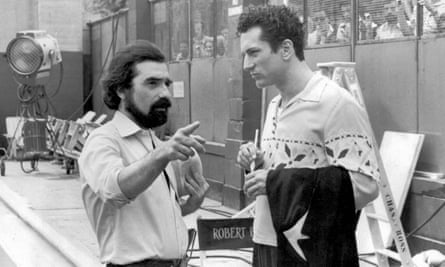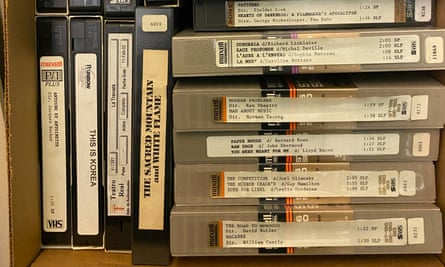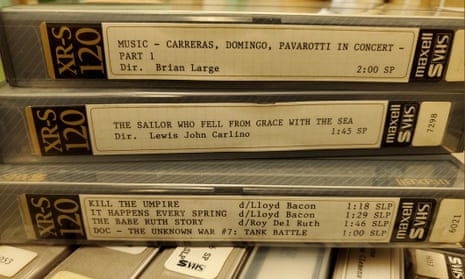In the basement of the University of Colorado Boulder’s main library, an 85-year-old stone fortress built in the Italian rural style, the archives of the school’s Rare and Distinctive Collections occupy rows of shelves as far as the eye can see. Here, amid yellowed books, historical maps and medieval manuscripts, Martin Scorsese has quietly made public a very private preoccupation. More than 50 storage boxes hold thousands of VHS tapes that contain films and television programs Scorsese recorded directly from broadcast television. The renowned director and film preservationist, it turns out, was also, for decades, a prolific guerrilla archivist.
Long before YouTube and Netflix gave the world instant access to a deep repository of media, Scorsese began the project of amassing his own private on-demand video library. In each week’s TV Guide, he would note the movies and shows that caught his interest. A full-time video archivist in Scorsese’s New York office would then record the telecasts from a kind of audiovisual hub made up of multiple VCRs and monitors, which could often be active at all hours. The tapes were meticulously labeled, cataloged initially using a library-like card system and later a computer, and filed away for Scorsese’s personal viewing and research.
Spanning the 1980s through the 2000s, the Martin Scorsese VHS Tape Collection contains more than 4,400 distinct titles, including features, documentaries, shorts, history programs and award shows. Perusing the online catalogue, you’ll find everything from European arthouse masterpieces to an episode of Live with Regis and Kathie Lee featuring Scorsese’s beloved mother, Catherine, who made regular cameos in her son’s films. As the archive steadily grew, Scorsese made the videos an essential part of his film-making process. Typically during pre-production, he would ask his archivist to pull tapes of various films, many of which were not otherwise available on home video. He would then hand out the tapes to the cast and crew to serve as reference materials.

“I do that on most of my pictures,” Scorsese said in a written interview. “For the actors, it’s usually about tone, mood, a certain emotional state, a suggestion of the world we’re working to create. With crew members, it’s often a cut, a camera movement at a specific point in the story, a certain way of framing. Not copying anything, but suggesting a way of approaching the question of how we’re going to tell the story.”
The collection is also a physical manifestation of his famously omnivorous appetite for visual media. Scorsese has frequently spoken about growing up asthmatic in a New York City household that lacked books but was one of the first on the block to get a television set in 1948, when he was six years old. For young Marty, who wasn’t able to play in the streets as frequently or vigorously as other kids, the 16-inch screen of the black-and-white RCA Victor in the living room became his window to the world – and, critically, his first exposure to great cinema.
On Friday nights, a New York station would show Italian neorealist films, and he would sometimes watch them in the company of family members who had immigrated from Sicily; he was struck, particularly, by the work of Roberto Rossellini, which he would later explore in his 1999 documentary My Voyage to Italy. In the mid-to late ’50s, Scorsese’s eyes were peeled to Million Dollar Movie, a program that showed the same film twice a day during weekdays and three times a day on weekends, allowing him, on multiple viewings, to begin thinking about how a movie like Citizen Kane was crafted – the movement of the camera, the use of music, the employment of effects such as slow motion. From grade school through his NYU days, Scorsese would do his homework as images from a muted TV flickered in front of him; much later, he brought the habit into the editing room while cutting his own films with his longtime editor Thelma Schoonmaker. He has admitted to feeling a sense of loneliness outside the presence of a television.

“He was always voraciously watching, absorbing, learning,” said Paul Mougey, who was an NYU film student when he became Scorsese’s video archivist for four years in the mid- to late ’80s. Shortly thereafter, in 1990, Scorsese formed the non-profit Film Foundation, which has since helped to restore more than 1,000 films. “Marty wanted to get every movie there ever was, and we recorded everything,” Mougey says. “He felt part of his mission as a preservationist was to create this amazing library – and share it with his friends.”
Mougey fondly recalls the day at Scorsese’s office, then located in New York’s historic Brill Building, when “Bobby” De Niro turned up in boat shoes to pick up a VHS tape containing a film Scorsese wanted him to see before they began shooting Goodfellas. “I just remember thinking he was such a relaxed dude. Very quiet, very polite, very nice,” says Mougey, who landed a cameo as Terrorized Waiter in the 1990 gangster classic. One of Mougey’s successors, Kent Jones, would rise from video archivist to regular Scorsese collaborator, including co-writing A Life of Jesus, which is slated to be Scorsese’s follow-up to last year’s Killers of the Flower Moon.
Several years ago, Scorsese began slowly donating the VHS collection. The wide availability of high-resolution DVD and Blu-Ray, as well as the rise of streaming, had diminished the usefulness of much of the hulking tape archive. Scorsese’s longtime film archivist, Mark McElhatten, and Scorsese’s final video archivist, Gina Telaroli, were friends of Erin Espelie, an associate professor of film at the University of Colorado Boulder. They collaborated to facilitate the university’s acquisition of the collection. In 2021, the final boxes of tapes arrived in Boulder from Scorsese’s Sikelia Productions office in Manhattan.
The University of Colorado Boulder might seem a curious home for Scorsese’s collection. The 81-year-old is cinema’s foremost chronicler of New York life. He is a New York University alum and onetime teacher at NYU’s undergraduate film-making program. In 2021, NYU’s Tisch School of the Arts established the Martin Scorsese Institute of Global Cinematic Arts, which encompasses both a production center and cinema studies department that bear his name. Still, the Rare and Distinctive Collections in Boulder has positioned itself as a center for scholarship on the history of film and video. It houses significant collections from the influential experimental film-makers Stan Brakhage and Ken and Flo Jacobs.
“Ultimately, I believe Scorsese honored the experimental film roots of the University of Colorado Boulder and respected our interest in intertwining archival work with teaching,” Espelie said via email. “Our hope in the Department of Cinema Studies and Moving Image Arts is that students, scholars, and community members will come to the Scorsese VHS archive for various purposes: to learn more about how Scorsese relied on the work of others to inform his film-making practice; how Scorsese was a voracious viewer; what movies and programs he watched (and then often shared with cast members); and, from a more documentary perspective, what was playing on television.”

The broadcast recordings include commercials, bumpers and other marginalia, which Espelie said “are as fascinating, in some cases, as the originally desired main recording events. Because of the way television lacked backups, these VHS tapes may provide some of the only copies of these ‘interstitial’ materials.”
For the archivists at the Rare and Distinctive Collections, the most pressing issue at the moment is the preservation of the Scorsese collection. Magnetic media degrades as it ages. It is believed that a VHS tape begins to progressively lose image quality after only 10 years. Some of Scorsese’s tapes are more than 40 years old. And so the entire archive must be digitized – a major undertaking. Converting thousands of hours of analog recordings is slow, tedious work. For the moment, the university requires the person requesting materials to pay for the digitization of any tape that hasn’t already been converted.
Once the collection is readily accessible, the University of Colorado Boulder associate film professor Tiel Lundy expects researchers to begin conducting comparative analyses, pinpointing what Scorsese was watching at a given time and how that media may have informed the work he went on to create. “This could be a tremendous book project,” she said.
Upon being informed of the existence of the Scorsese trove, John Klacsmann, an archivist at Anthology Film Archives in New York, immediately became intrigued by the notion that the director may have captured some true rarities on tape. “I’m certain there are some very rare and interesting copies of films, television broadcasts, and director’s cuts within this collection: deep cuts and obscurities that may have never been released on videotape, commercially or otherwise,” he said via email. “What kind of 1980s viewing list led to cinematic masterpieces like The King of Comedy and The Last Temptation of Christ? I’m certainly curious to know.”
